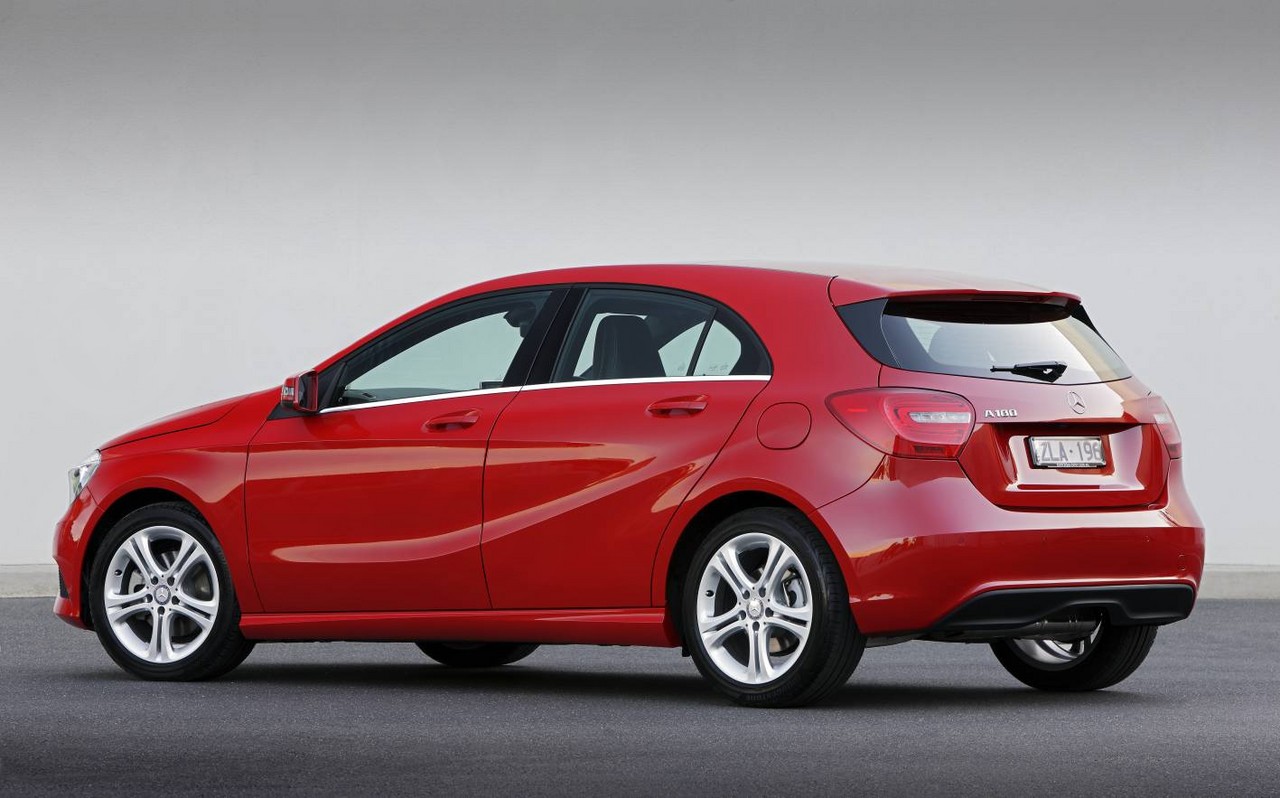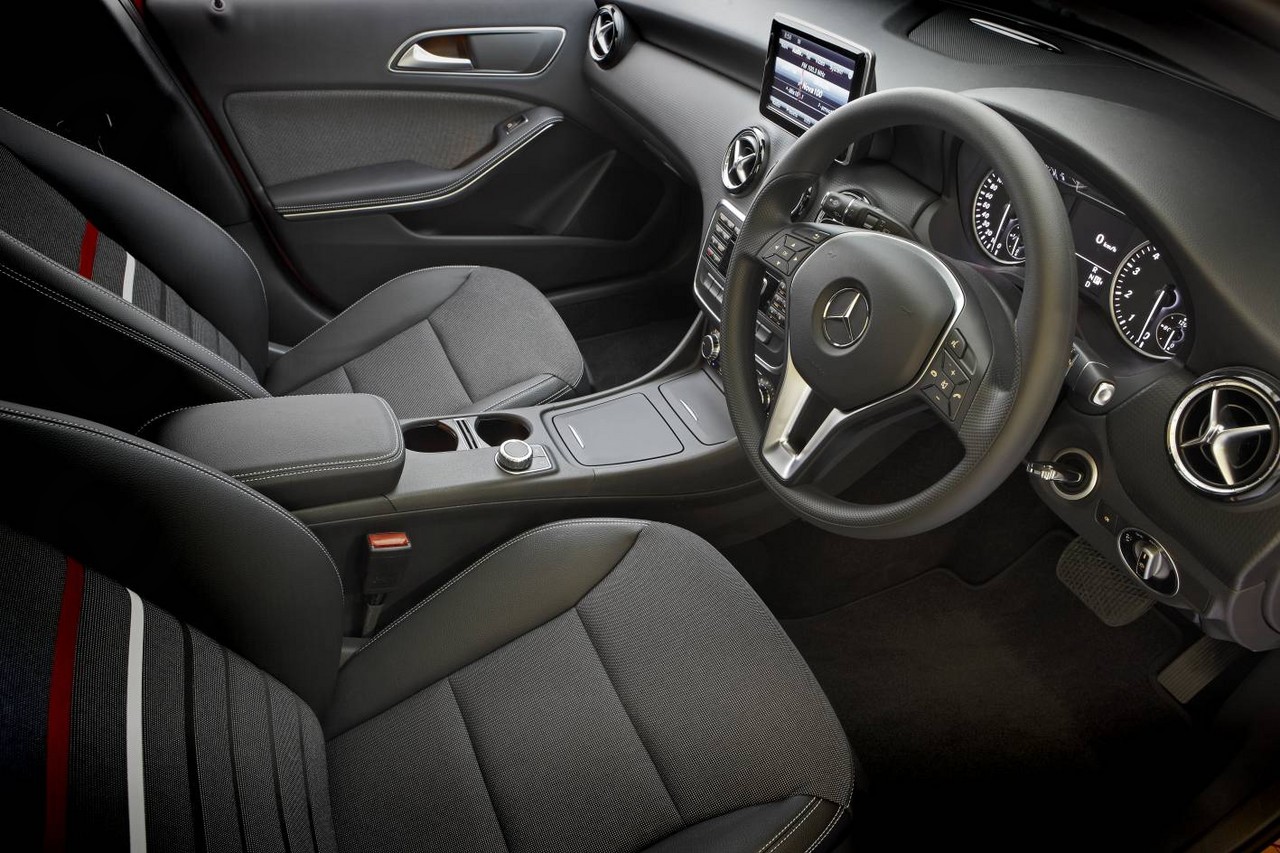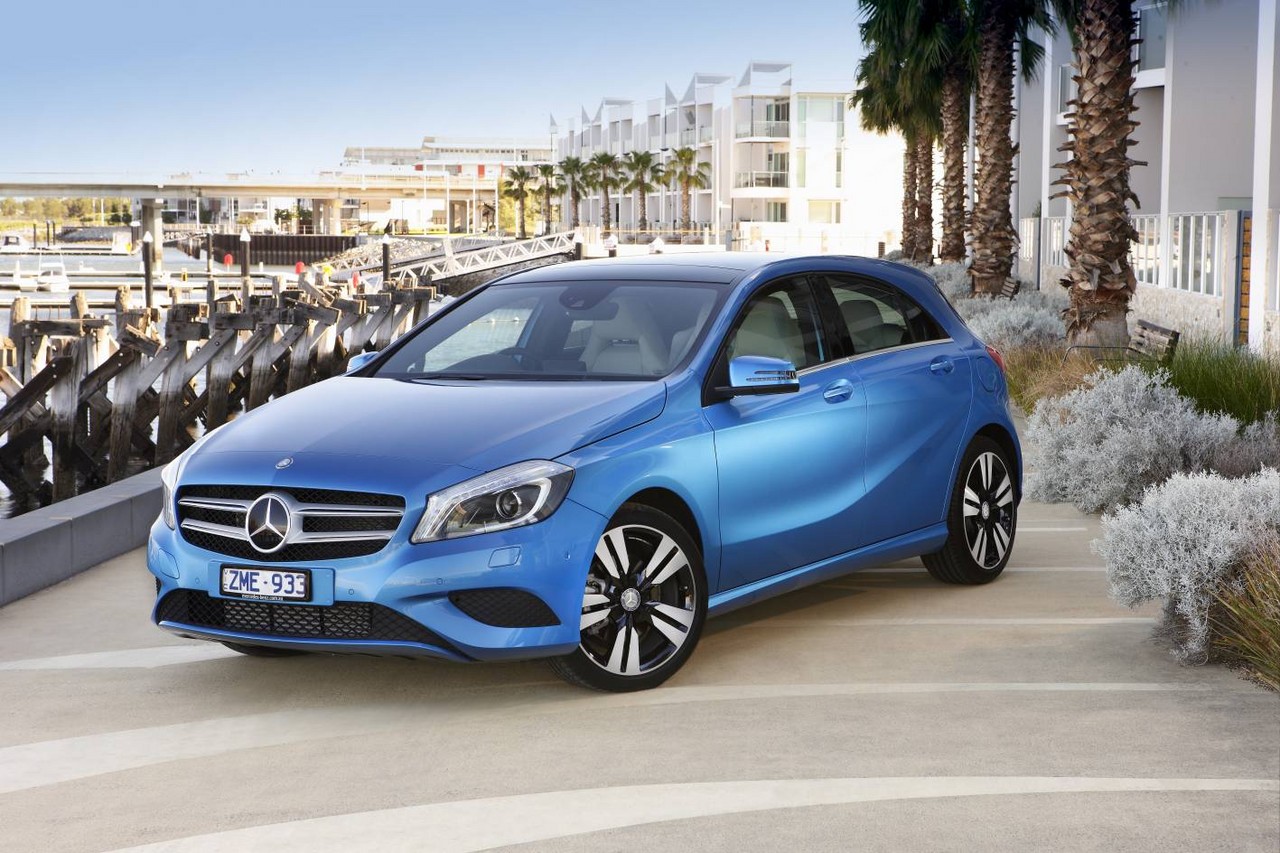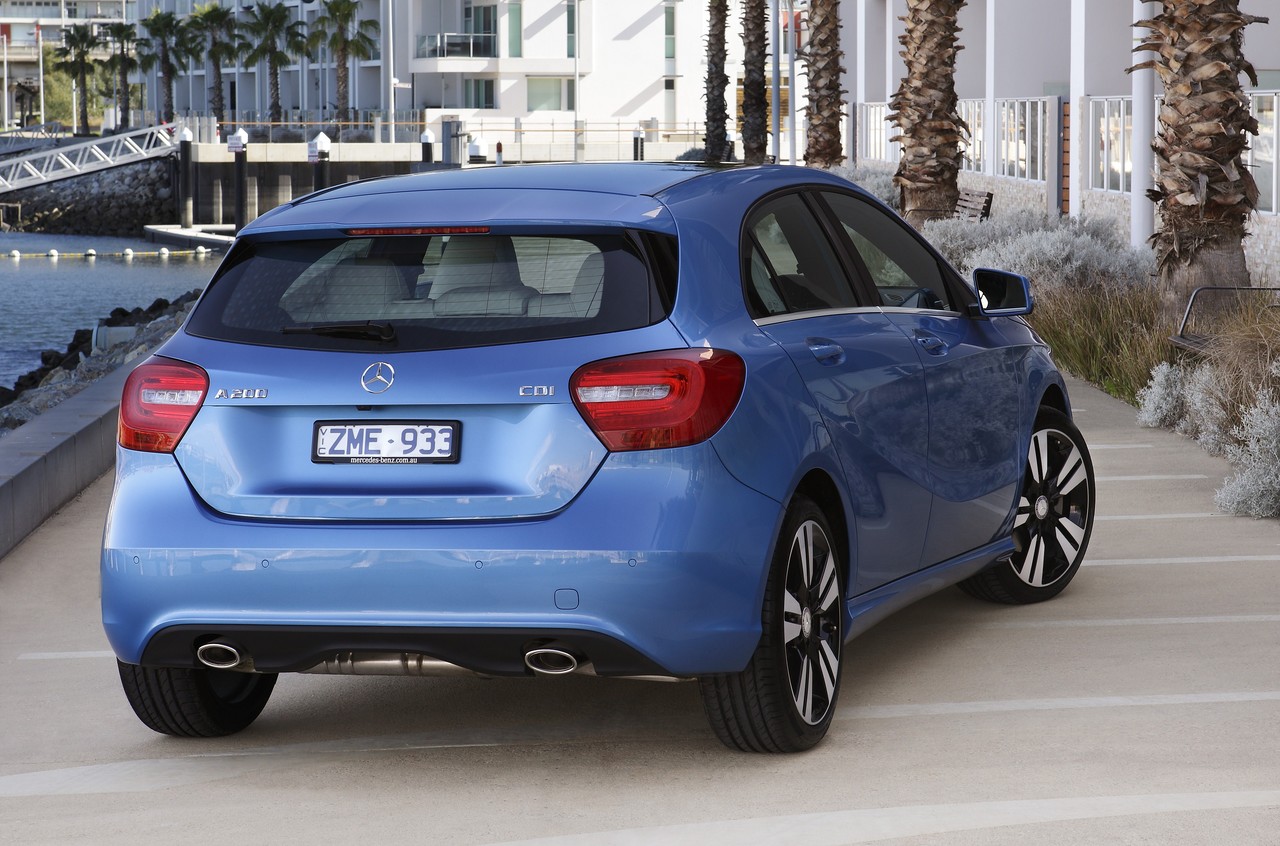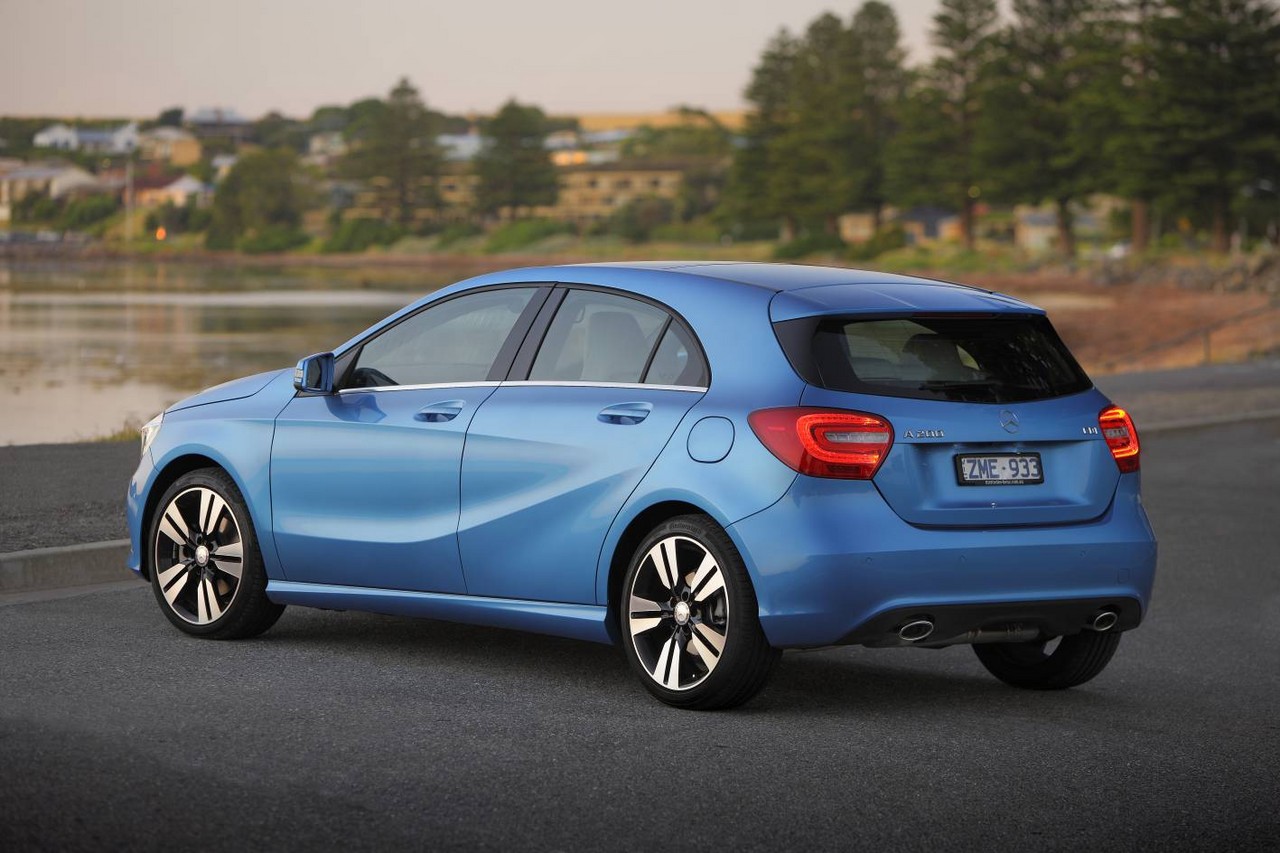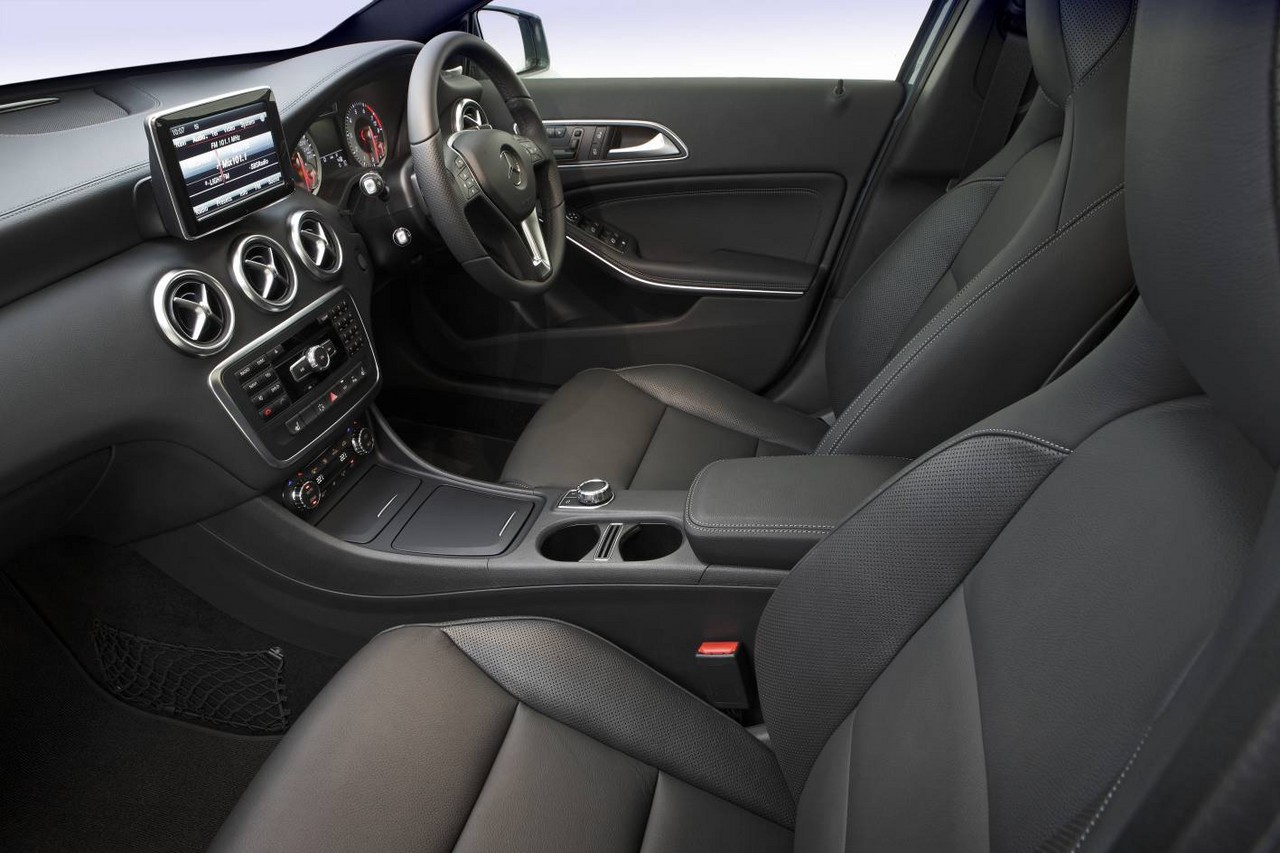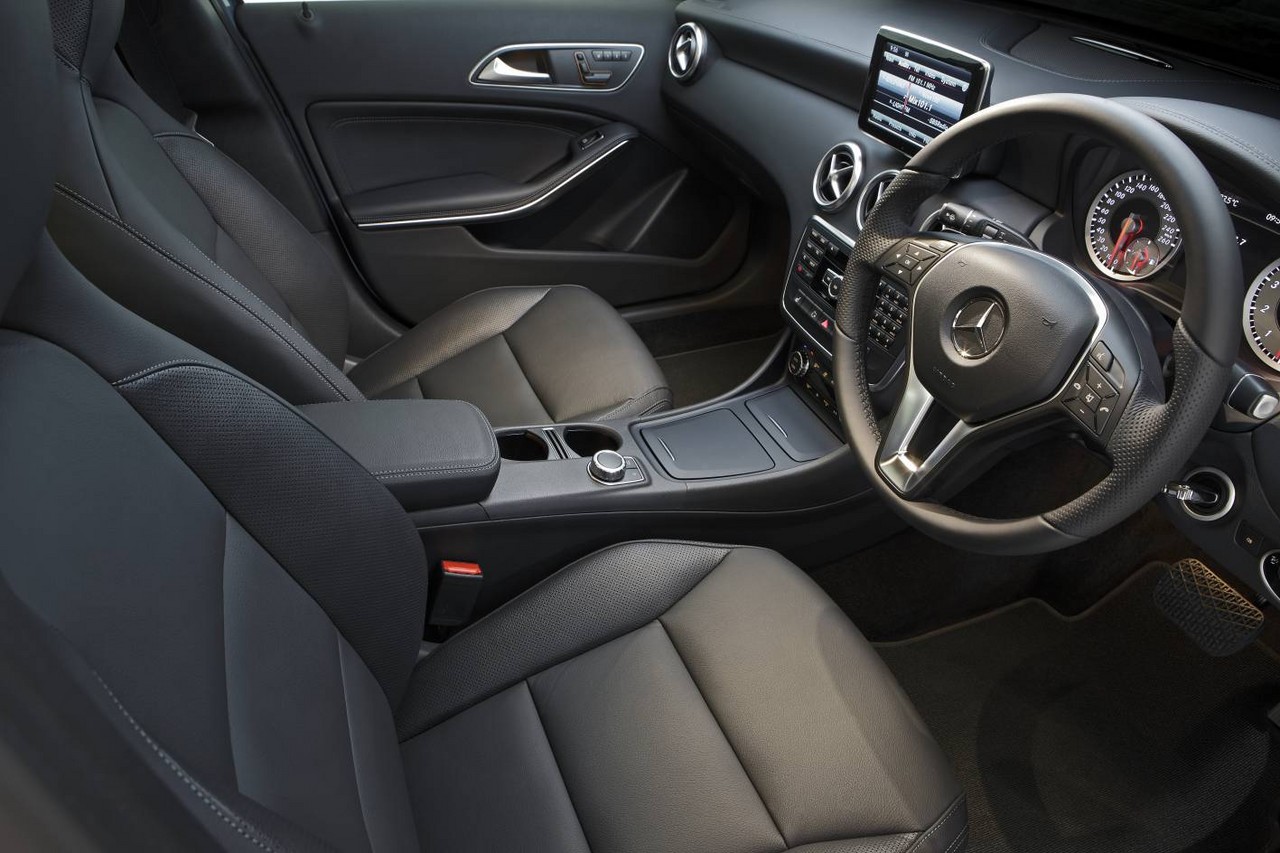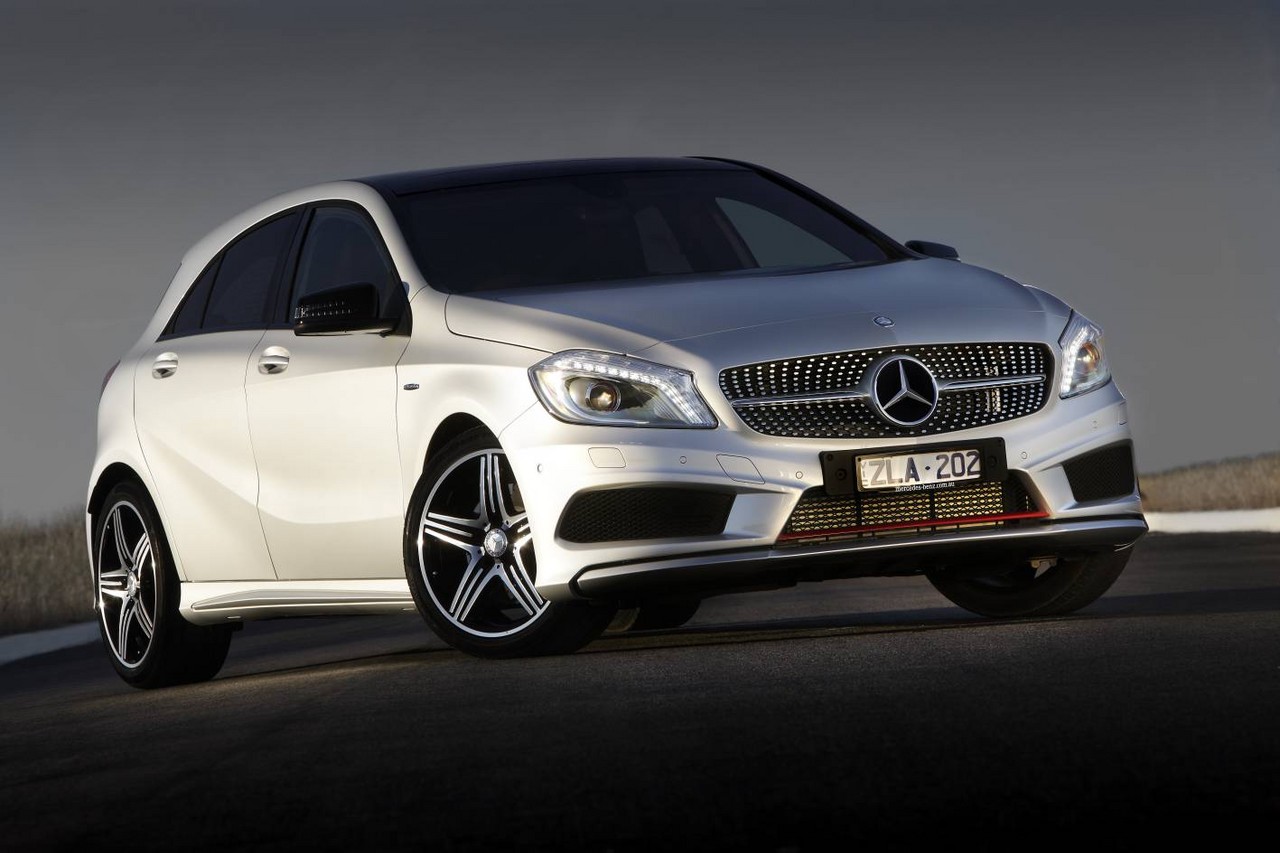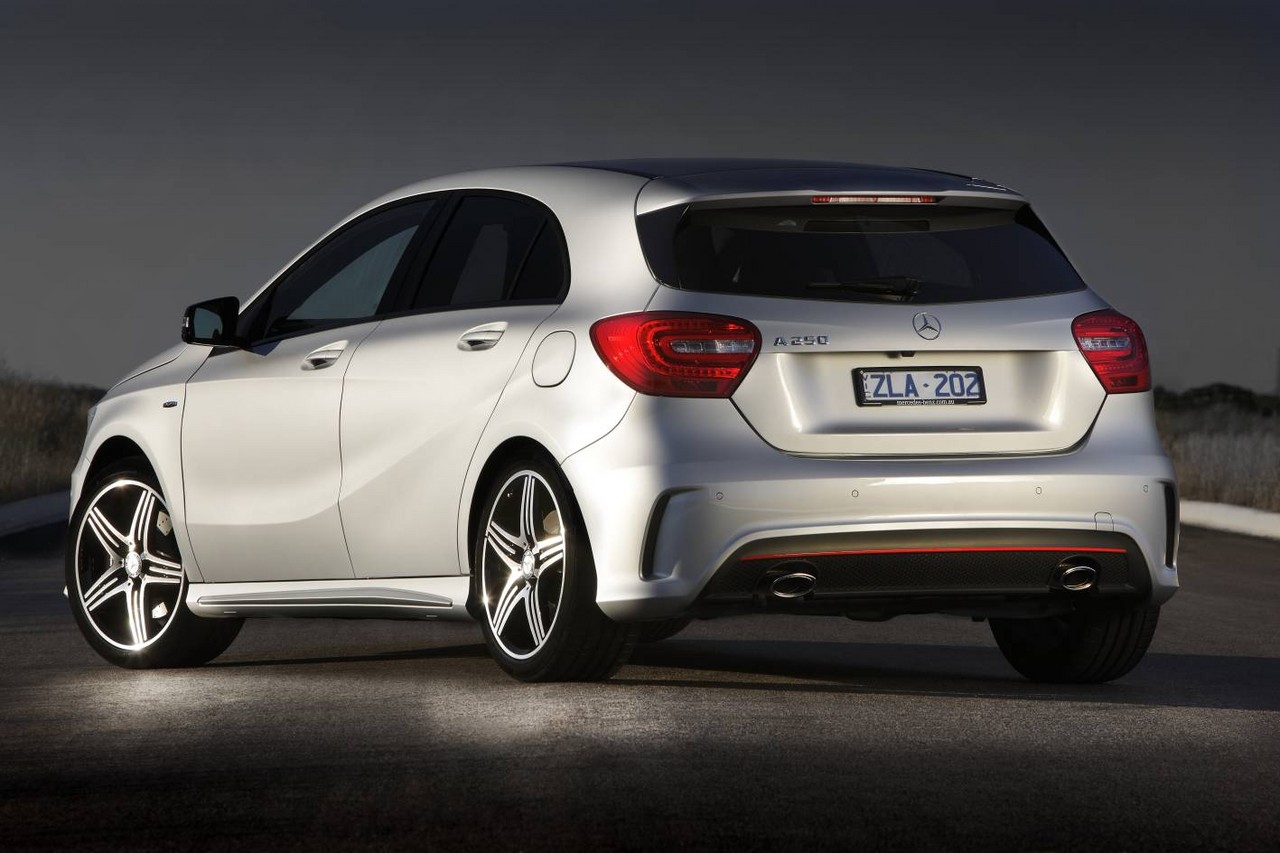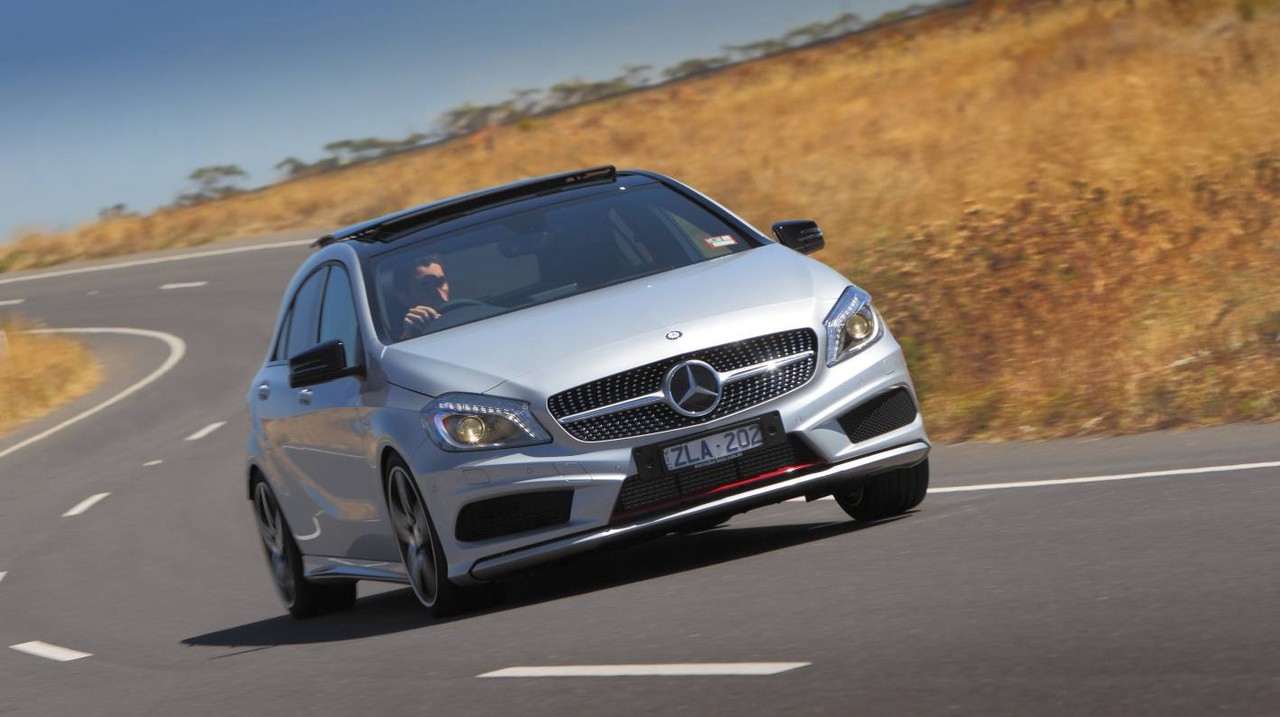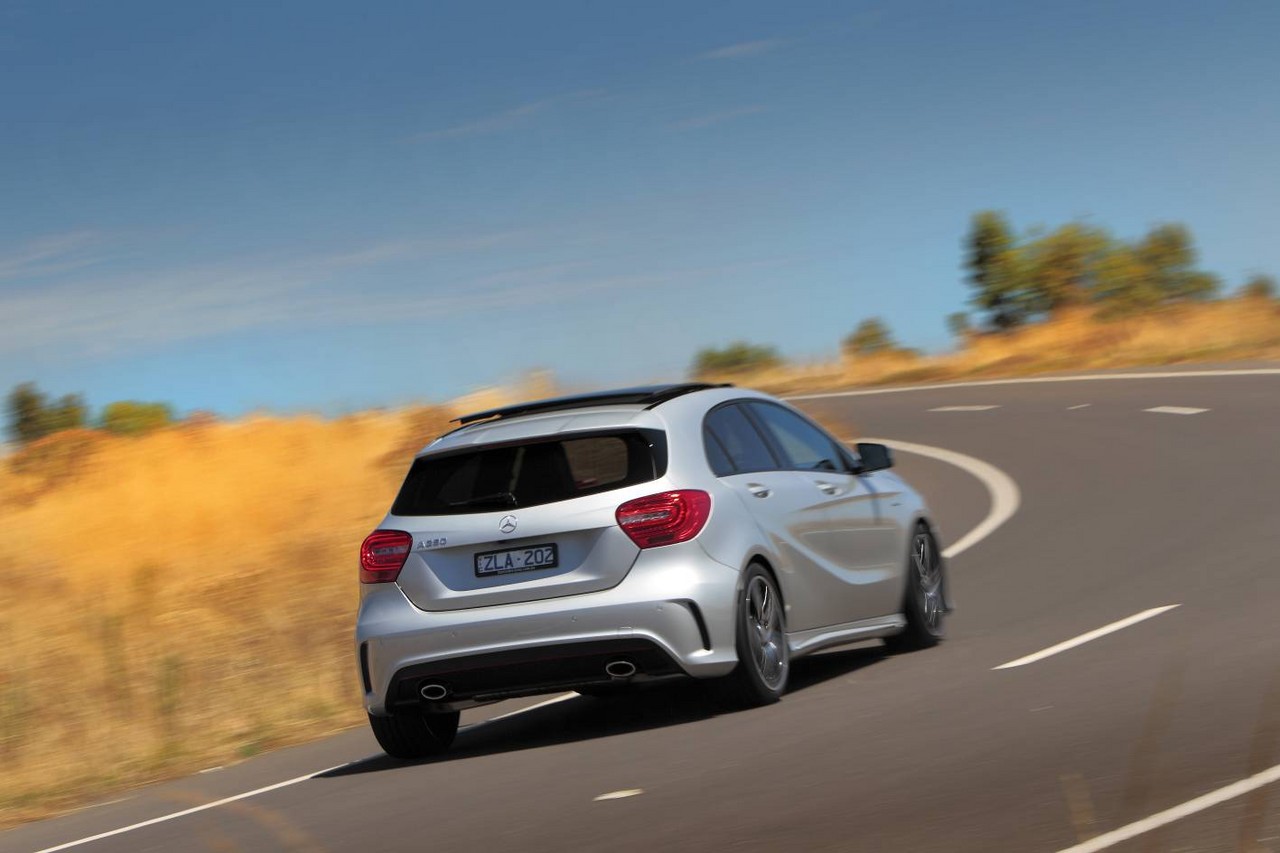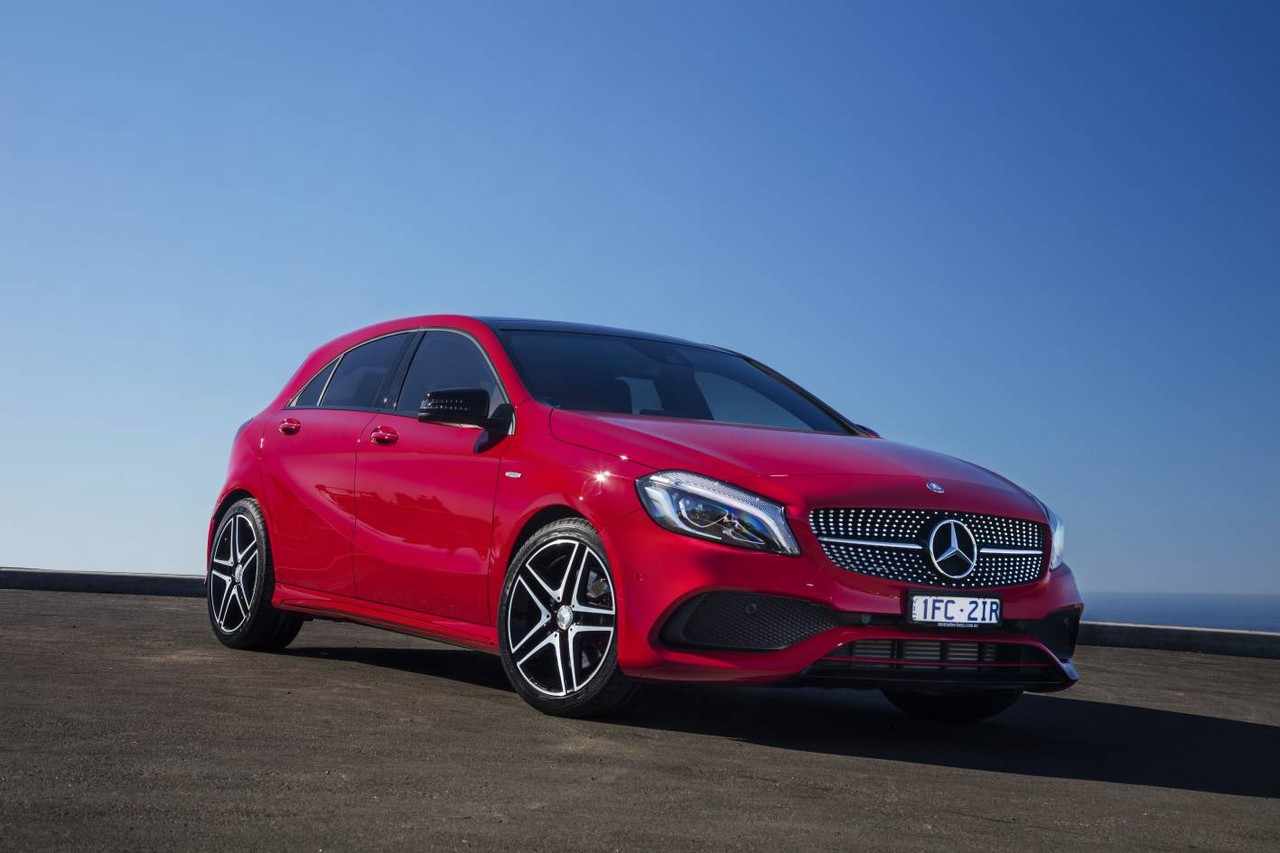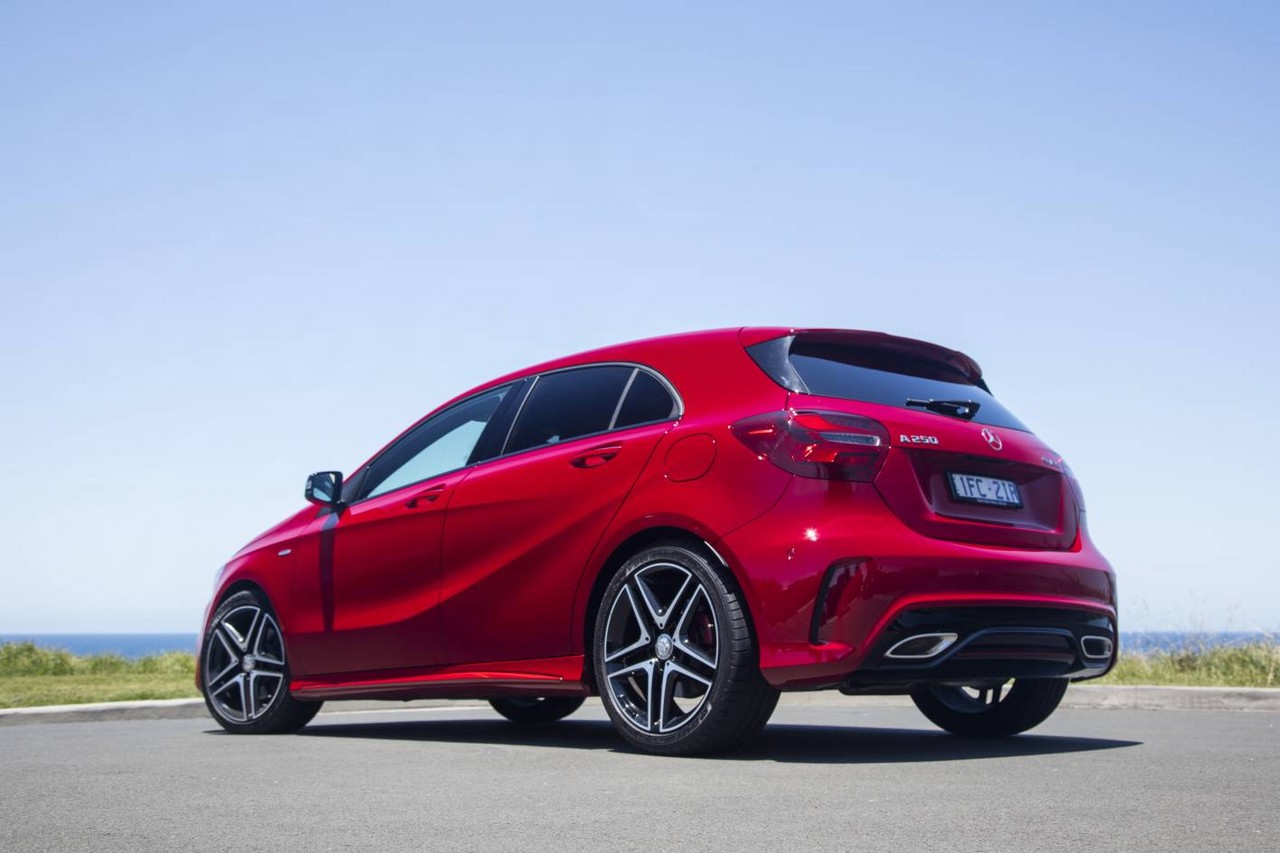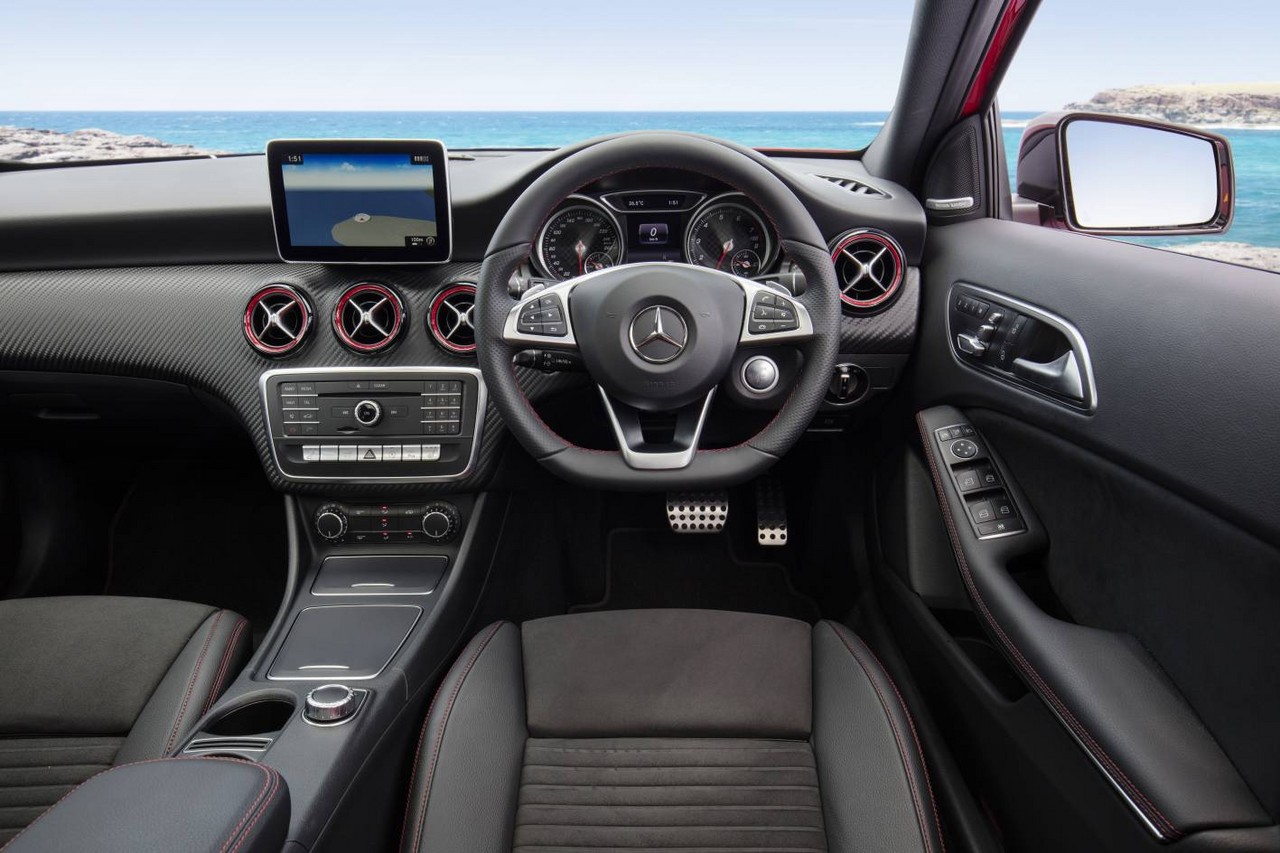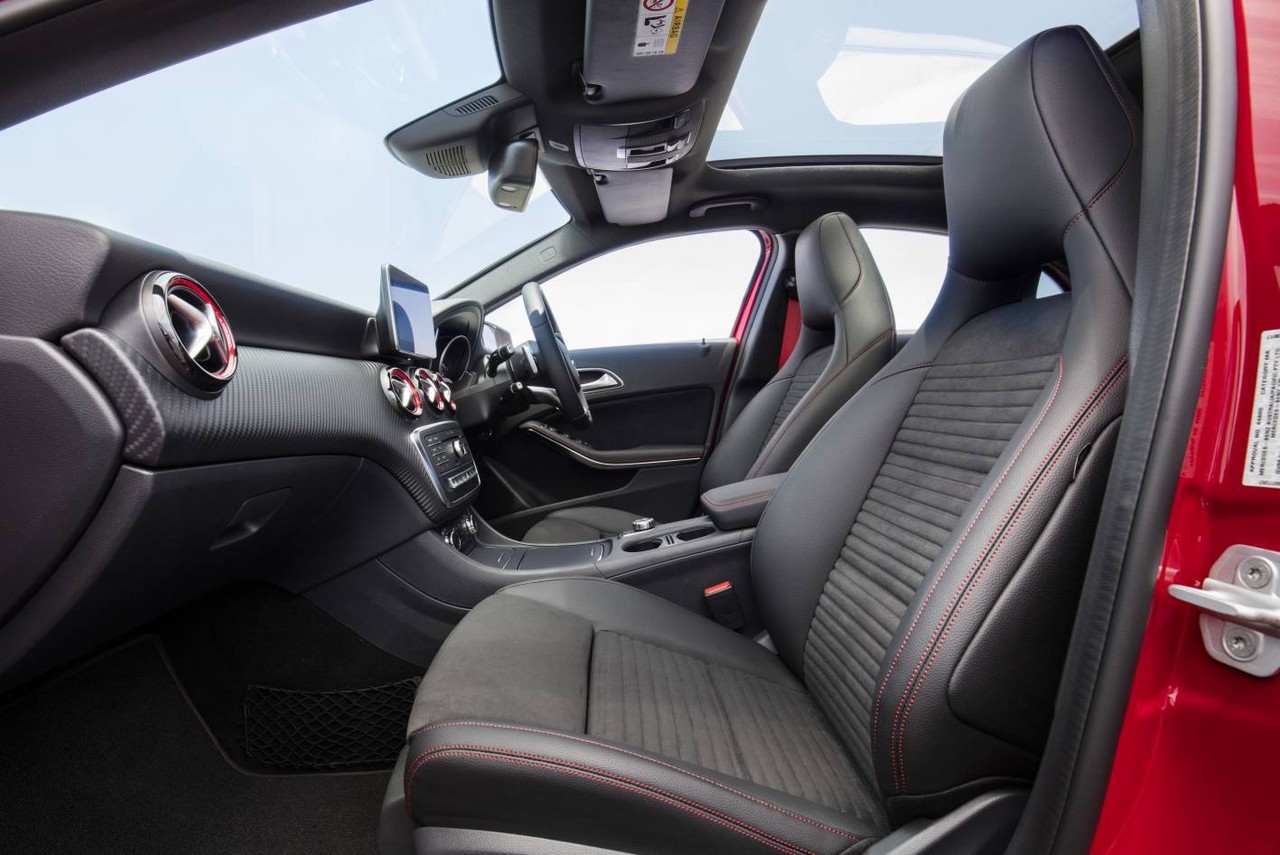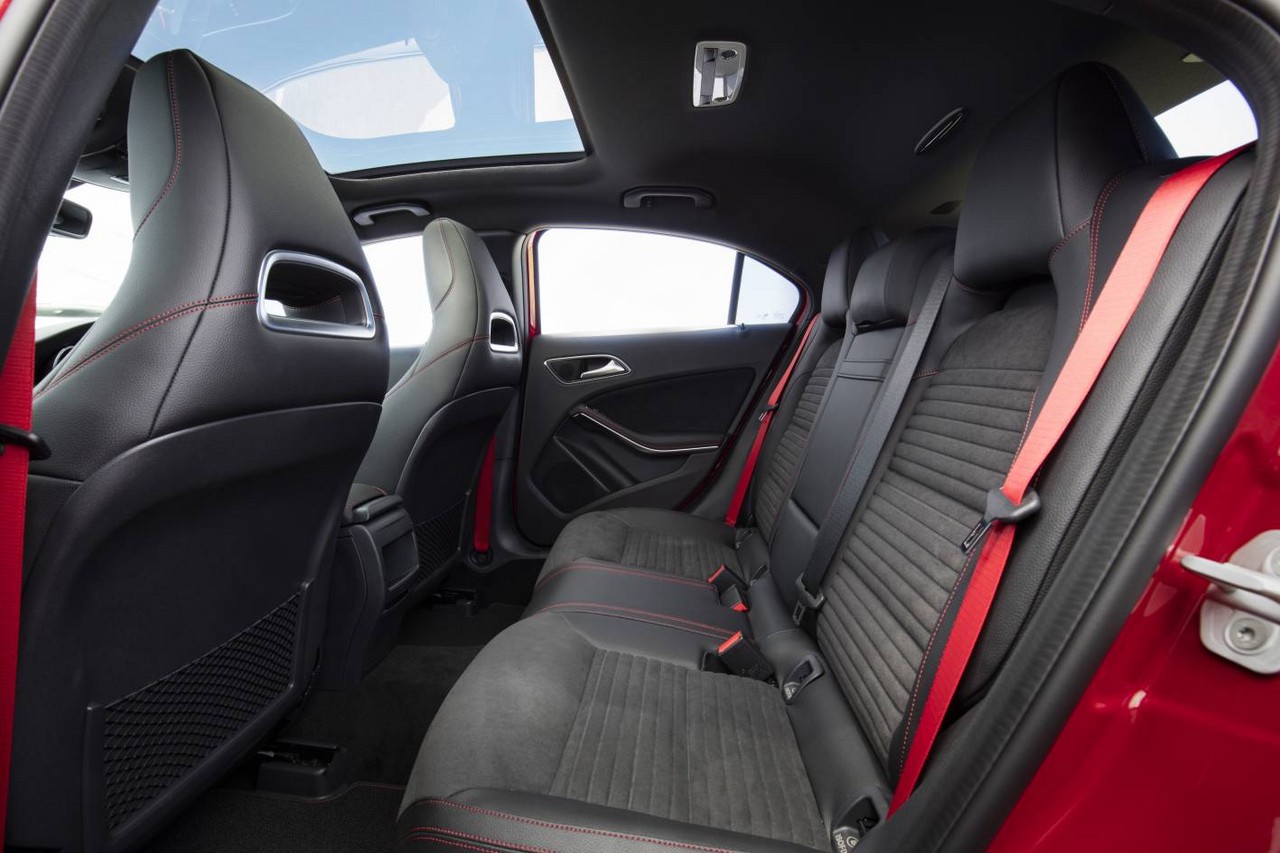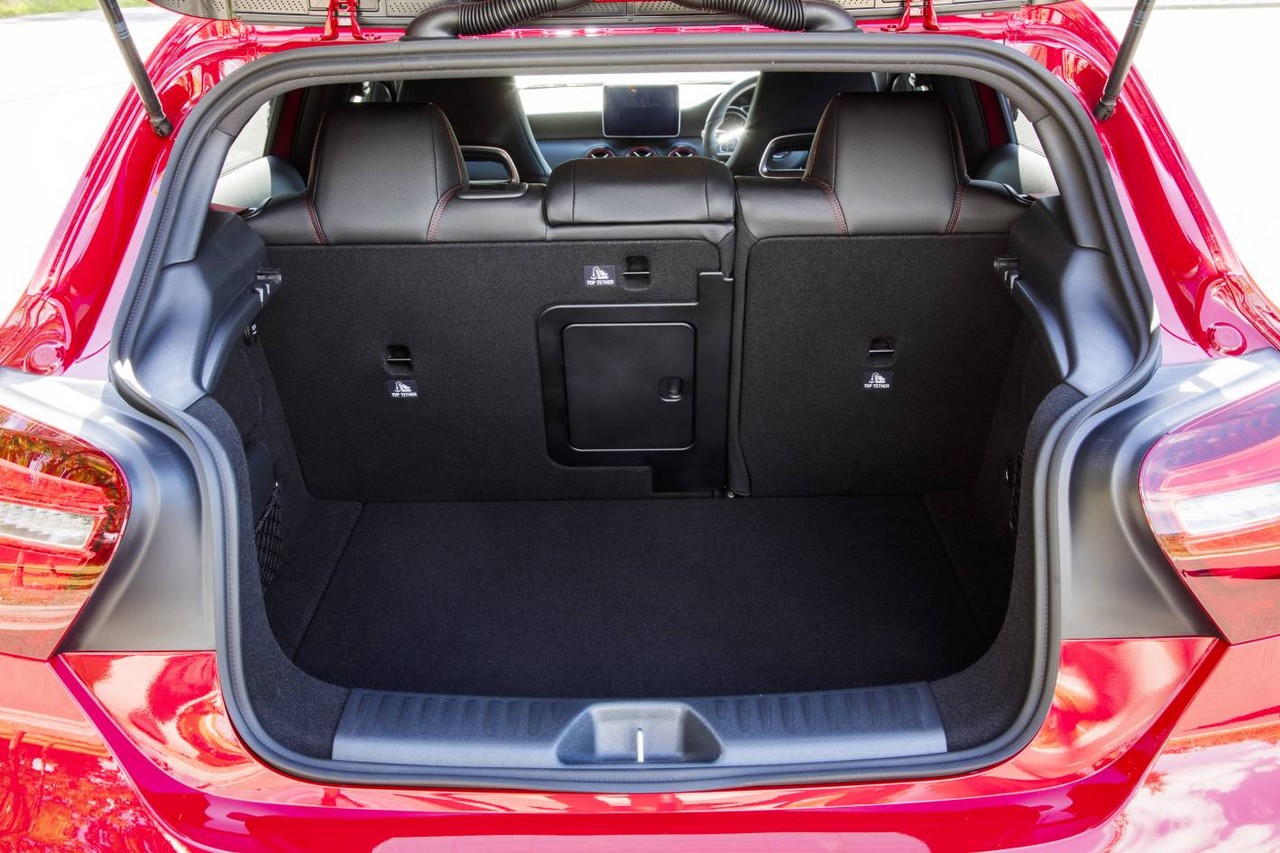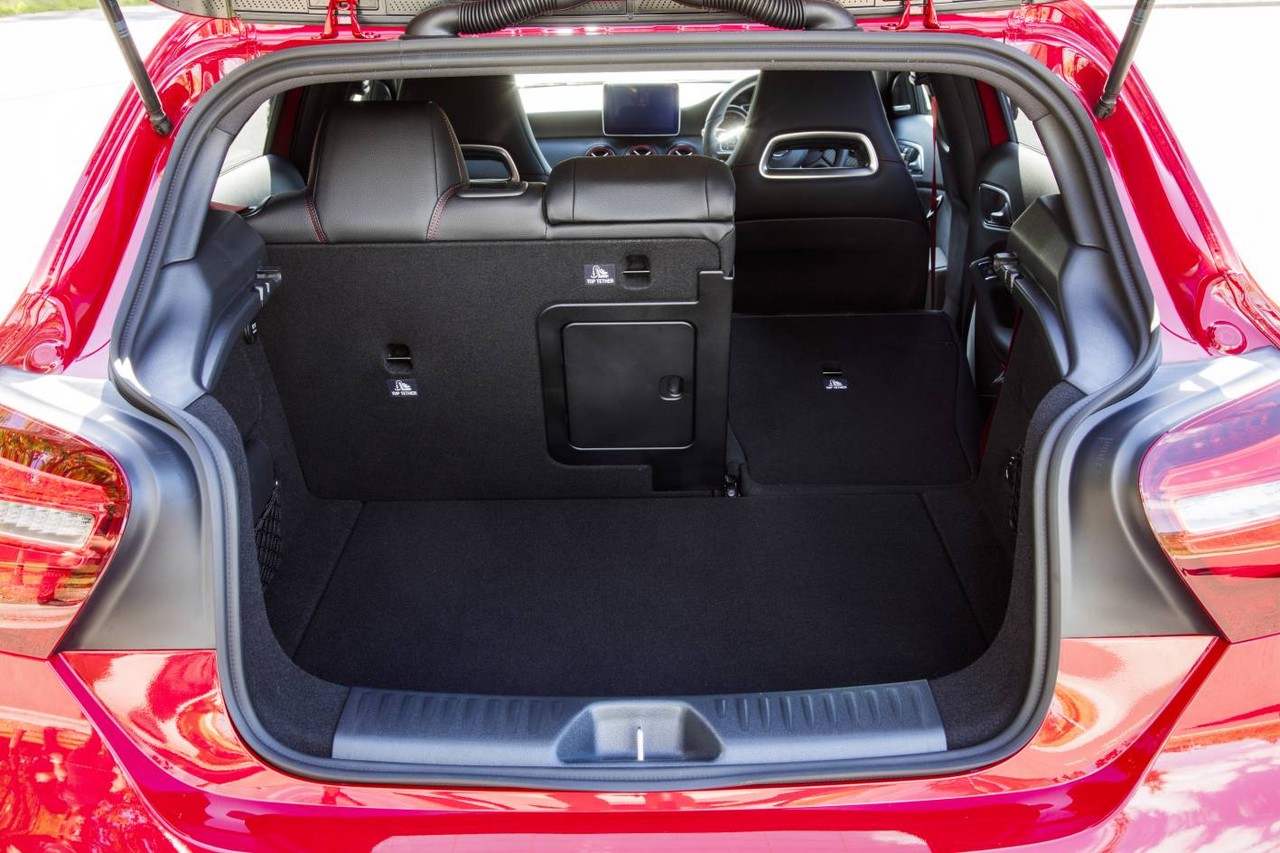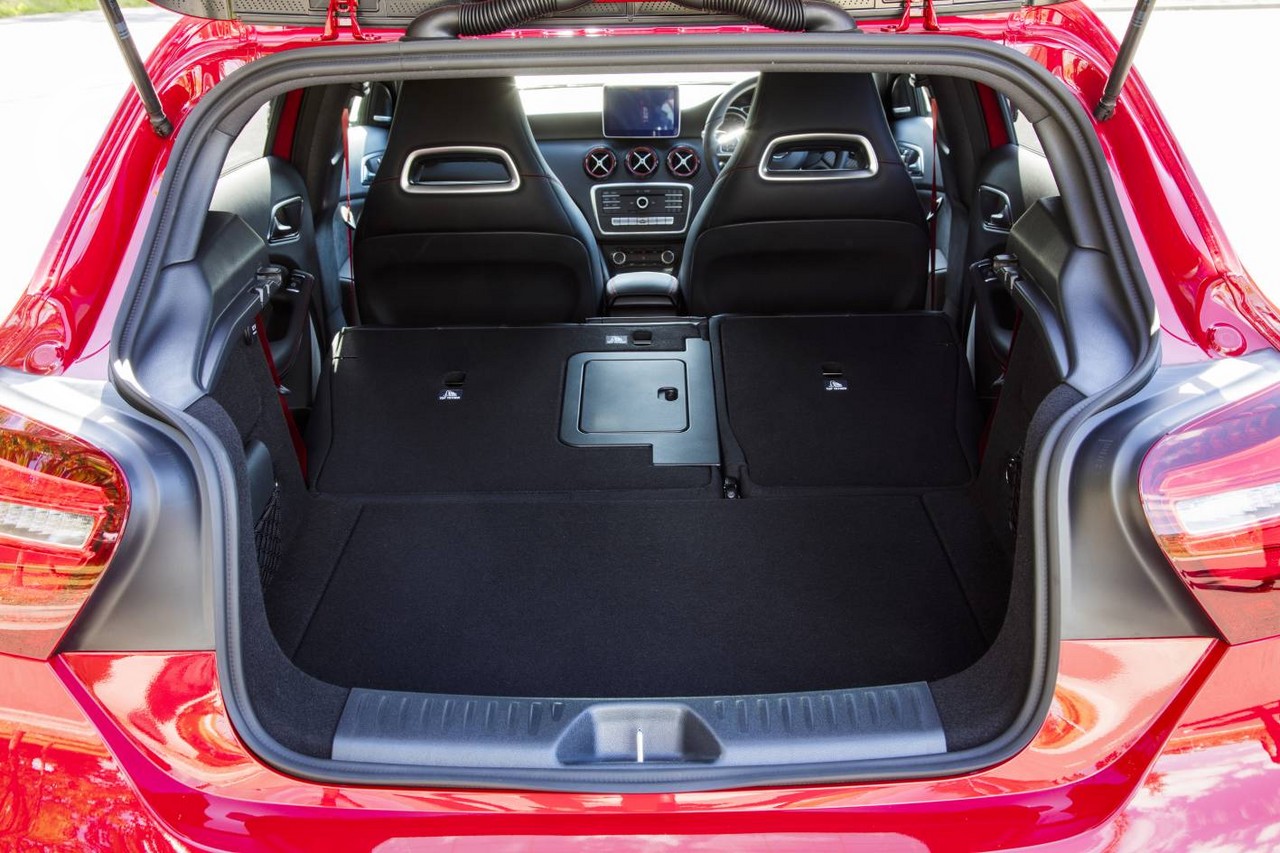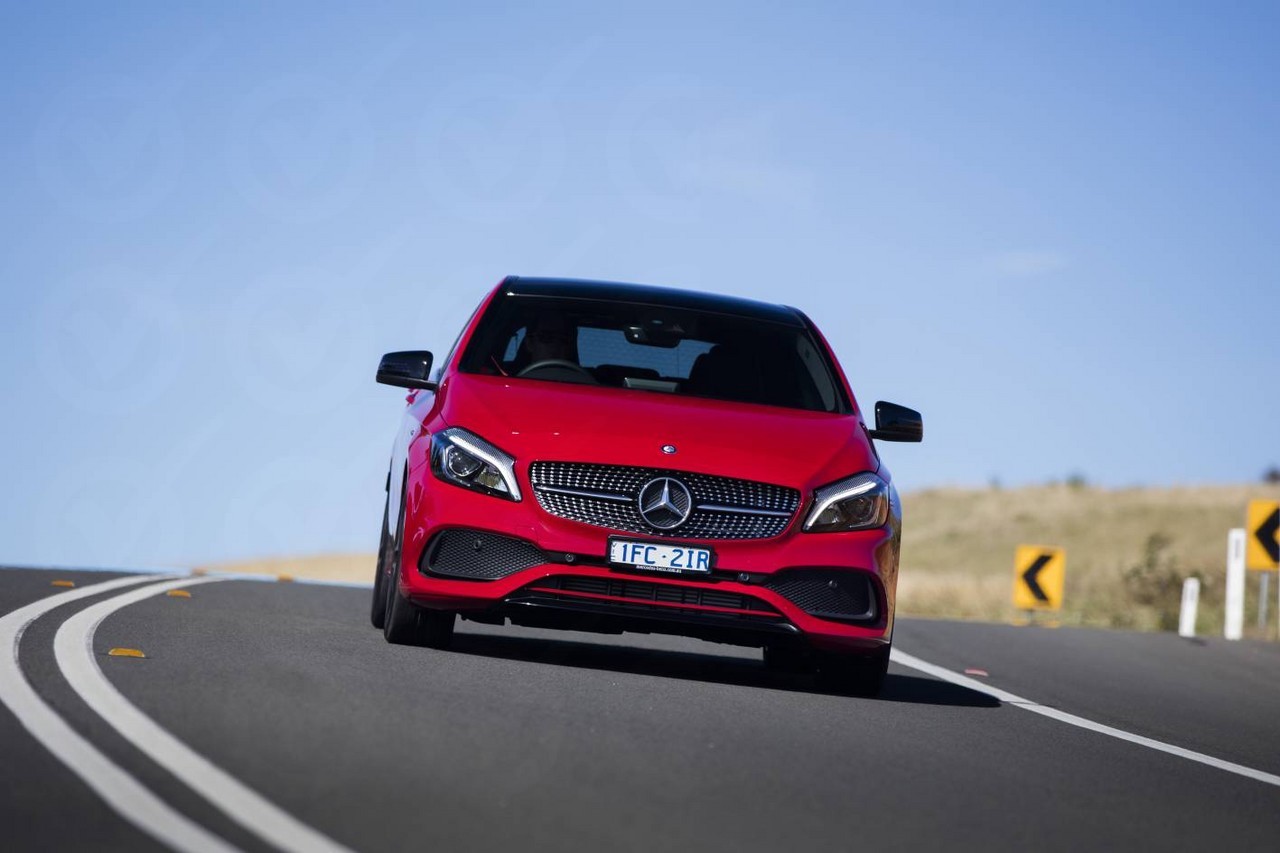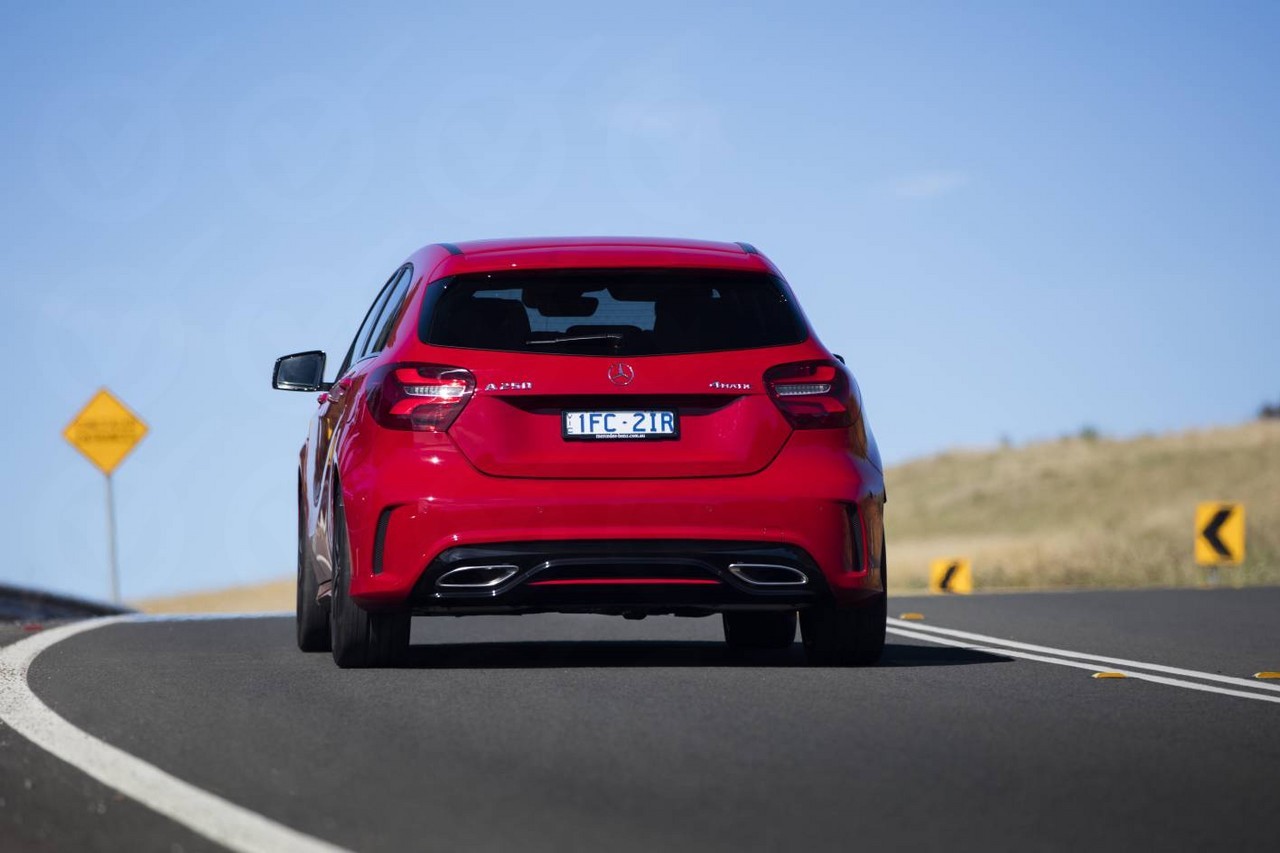
- Frugal turbo-diesel engines
- Accomplished dynamics
- Accurate, well-weighted steering
- Suspension is under-damped and provides an overly firm ride
- For A 180, A 200 and A 200 CDI, run-flat tyres can be noisy
- Limited rear seat headroom and poor rear visibility
- Noisy turbo-diesel engines
Review: Mercedes-Benz W176.I A-Class (2013-15)
Overview
Released in March 2013, the Mercedes-Benz W176 A-Class was a small five-door hatchback. Manufactured in Rastatt, Germany, the W176 A-Class range initially consisted of the front-wheel drive A 180, A 200, A 200 CDI and A 250 Sport models.
Please note that the Mercedes W176 A 45 AMG has been reviewed separately.
Drivetrains
For W176 A-Class, all models had a start/stop function which enabled the engine to shut down when the vehicle was stationary to minimise fuel consumption. Furthermore, the 7G-DCT dual-clutch transmission consisted of an automated three-shaft manual transmission with two subtransmissions (each with its own clutch) and offered three gearshift modes:
- Economy: fully automated gearshifts with an emphasis of low rev engine performance;
- Sport: fully automated gearshifts with faster and more responsive gearshifts; and,
- Manual: gearshifts shifts performed via steering wheel gearshift paddles (fitted as standard).
| Engine | Trans. | Peak power | Peak torque | |
|---|---|---|---|---|
| A 180 | 1.6-litre turbo petrol I4 (M270 DE16) |
7sp DCT | 90 kW at 5000 rpm |
200 Nm at 1250-4000 rpm |
| A 200 | 1.6-litre turbo petrol I4 (M270 DE16) |
7sp DCT | 115 kW at 5000 rpm |
250 Nm at 1250-4000 rpm |
| A 200 CDI | 1.8-litre turbo-diesel I4 (OM651 DE18) |
7sp DCT | 100 kW at 3600-4400 rpm | 300 Nm at 1600-3000 rpm |
| 2.1-litre turbo-diesel I4 (OM651 DE22) |
7sp DCT | 100 kW at 3400-4000 rpm | 300 Nm at 1400-3000 rpm | |
| A 250 Sport | 2.0-litre turbo petrol I4 (M270 DE20) |
7sp DCT | 155 kW at 5500 rpm | 350 Nm at 1200-4000 rpm |
Dimensions and suspension
Compared to the W169 A-Class , the Mercedes-Benz W176 A-Class was 409 mm longer (at 4292 mm), 16 mm wider (1780 mm), 160 mm lower (1433 mm) and had a 131 mm longer wheelbase (2699 mm); the centre of gravity and seating position were also lowered by 24 mm and 174 mm, respectively. Like the W246 B-Class with which it shared its platform, the W176 A-Class had MacPherson strut front suspension and independent, four-link rear suspension.
Safety equipment
Standard safety equipment for the Mercedes-Benz W176 A-Class included dual front airbags, a driver’s knee airbag, front and rear side airbags, full-length curtain airbags, ABS, electronic brake force distribution, brake assist, electronic stability control, traction control and front seatbelts with pre-tensioners and force limiters.
As standard, the Mercedes-Benz W176 A-Class was also fitted with:
- Mercedes-Benz’s ‘Pre-Safe’ which was activated by emergency braking, panic braking, pronounced over- or under-steering, critical steering movements or heavy support by the adaptive Brake Assist system. In response, Pre-Safe would prepare for a collision by deploying the seatbelt tensioners, close the side windows and sliding sunroof (where fitted) and adjust of the front passenger seat to an ideal position for maximum effectiveness of the restrain systems;
- Collision Prevention Assist (radar-based collision warning with adaptive Brake Assist): operated at speeds between 7 km/h and 250 km/h and could detect a collision risk when driving at speeds between 30 km/h and 250 km/h, and detect stationary objects when driving at speeds of up to 70 km/h. Collision Prevention Assist monitored the distance to the vehicle ahead, would provide visual and audible warning to the driver if there was a collision risk and would optimise braking power (adaptive Brake Assist) for when the driver depressed the brake pedal;
- An active bonnet which would rise in the event of a front-end pedestrian collision to create additional space between the bonnet and ‘hard points’ in the engine bay; and,
- Mercedes-Benz’s automatic emergency call system.
The W176 A-Class was fitted with a redesigned electromechanical power steering (EPS) system whereby the electric motor of the servo assistance system was located directly on the steering gear as a dual pinion EPS system. The EPS system also had the following functions:
- Countersteering in the case of oversteering;
- Corrective steering when braking on road surfaces with different levels of grip (split-friction braking);
- Mitigating the extent to which front-wheel drive influences the steering;
- Compensating cross winds and road gradients; and,
- Active Park Assist (fitted as standard).
Euro NCAP testing
In Euro NCAP testing , a 2012 Mercedes-Benz W176 A 180 received a five star safety rating which included a 93 per cent adult occupant protection rating and an 81 per cent child occupant protection rating. In the front offset crash test, protection for the front occupants was generally rated as good, though lower leg protection was only rated as adequate for both the driver and front passenger. Maximum points were awarded in the side impact test; in the more severe pole test, however, chest protection was rated as adequate.
Under ANCAP’s assessment scheme, the W176 A-Class received a five star adult occupant protection rating with a score of 35.8 out of 37.
Features: Mercedes-Benz W176 A 180
Standard features for the Mercedes-Benz W176 A 180 included 17-inch five twin-spoke alloy wheels with 225/45 R17 run-flat tyres, a six speaker sound system with an ‘Audio 20’ media interface, six-disc CD changer, 14.7 cm colour display, MP3/WMA/AAC compatibility, auxiliary inputs (3.5 mm/USB/iPod) and Bluetooth audio streaming, climate control air conditioning, cruise control, combination ‘Messancy’ fabric and ‘Artico’ (synthetic leather) seats, daytime running lights, a rear fog light, automatic headlights, rain-sensing wipers, front and rear parking sensors, a reversing camera with dynamic guidelines, 40/60 split and folding rear seats, Bluetooth mobile phone connectivity, remote central locking, power windows and heated mirrors, ambient lighting, tinted windows, a trip computer and an immobiliser.
Features: Mercedes-Benz W176 A 200 and A 200 CDI
The Mercedes-Benz W176 A 200 and A 200 CDI were further equipped with 18-inch five twin-spoke alloy wheels in bi-colour black with 225/40 R18 tyres, four-way power adjustable front seats, combination Larochette and Artico seats upholstery, a nappa leather steering wheel, power folding door mirrors, an automatically dimming rear-view and door mirrors, silver-coloured sports dial instruments, Artico centre door panel finishes. Visually, the A 200 and A 200 CDI could be identified by their twin louvre silver radiator grilles and twin exhaust outlets.
Features: Mercedes-Benz W176 A 250 Sport
The Mercedes-Benz A 250 Sport was differentiated by its 18-inch AMG five-spoke alloy wheels with 235/40 R18 tyres, perforated front brake discs, AMG sports suspension, combination Artico and ‘Dinamica’ microfiber seats, bi-xenon headlights with integrated daytime LED running lights, LED tail lights, a panoramic power sunroof and rear privacy glass.
Inside, the A 250 Sport had a flat-bottomed steering wheel, imitation carbon-fibre interior trim, ‘Dinamica’ microfibre centre door panels, stainless steel pedals, designo red seatbelts and contrasting red stitching for the seats, steering wheel, centre armrest and door armrests. Visually, the A 250 Sport was distinguished by its AMG body styling (front and rear aprons and side sill panels with red highlights), red painted front brake calipers and single louvre diamond grille.
Brochure
Related links
- Press Kit: Mercedes-Benz W176 A-Class (June 2012)
- Specifications: Mercedes-Benz W176 A-Class (June 2014)
Review: Mercedes-Benz W176.II A-Class (2015-18)
Overview
Commencing production in September 2015, the Mercedes-Benz W176 Series II (W176.II) A-Class introduced a revised range as the A 250 Sport was replaced by the all-wheel drive A 250 Sport 4MATIC and the A 200 CDI was renamed A 200 d. Significantly, the W176.II A-Class was fitted with electronically-controlled dampers as standard. For the 7G-DCT, the W176.II A-Class also introduced a ‘Launch Assist’ function for faster acceleration from rest.
The W176.II A-Class could be identified by its more arrow-shaped front bumper and newly designed tail lamps. Inside, the W176.II A-Class had a tubular design instrument cluster which featured dial graphics and anodised switches.
| Engine | Trans. | Peak power | Peak torque | |
|---|---|---|---|---|
| A 180 | 1.6-litre turbo petrol I4 (M270 DE16) |
7sp DCT | 90 kW at 5000 rpm |
200 Nm at 1250-4000 rpm |
| A 200 | 1.6-litre turbo petrol I4 (M270 DE16) |
7sp DCT | 115 kW at 5000 rpm |
250 Nm at 1250-4000 rpm |
| A 200 d | 2.1-litre turbo-diesel I4 (OM651 DE22) |
7sp DCT | 100 kW at 3200-3400 rpm | 300 Nm at 1400-3000 rpm |
| A 250 Sport 4MATIC | 2.0-litre turbo petrol I4 (M270 DE20) |
7sp DCT | 160 kW at 5500 rpm | 350 Nm at 1200-4000 rpm |
4MATIC all-wheel drive system
The Haldex all-wheel drive system for the A 250 Sport 4MATIC consisted of an electro-hydraulically controlled multi-disc clutch which was integrated with the rear axle differential. In normal driving, torque was directly entirely to the front wheels for optimum efficiency. If slip was detected at the front wheels, however, a hydraulic pump would instantaneously press the clutch discs together to direct up to 50 per cent of the engine’s torque to the rear axle (i.e. a 50:50 front:rear torque split). The all-wheel drive system provided a variable torque distribution, with the front:rear determined by vehicle speed, lateral and longitudinal acceleration, steering angle, speed difference between the individual wheels, selected gear and accelerator position.
Suspension
As standard, the W176.II A-Class was fitted with Mercedes-Benz’s ‘Dynamic Select’ which used a proportional valve at each shock absorber that was electronically actuated to control oil flow and, therefore, damping resistance. Dynamic Select used acceleration sensors to measure body movements and this information was combined steering angle, steering speed and yaw rate to calculate the desired damping rate. Furthermore, the driver was able to adjust the suspension’s damping characteristics by selecting from Comfort and Sport modes via the ‘Dynamic Select’ switch.
Safety equipment
Compared to the W176.I A-Class, the Mercedes-Benz W176.II A-Class was fitted with Collision Prevention Assist Plus (replacing Collision Prevention Assist Plus). Operating at speeds up to 250 km/h to monitor the traffic ahead and at speeds up to 50 km/h for stationary objects, Collision Prevention Assist would issue a visual warning (when driving at speeds over 7 km/h) and an optical warning (when driving at speeds over 30 km/h if there was a collision risk. At speeds below 105 km/h (250 km/h in conjunction with Distronic Plus), Collision Prevention Assist Plus would initially provide partial autonomous braking to reduce vehicle speed and alert the driver. Furthermore, adaptive Brake Assist would calculate the braking force required and prime the braking system for optimum response when the driver depressed the brake pedal. If the driver did not respond and a collision was unavoidable, then maximum braking force would be applied to reduce vehicle speed. At initial vehicle speeds of up to 40 km/h, rear-end collisions could be prevented;
Furthermore, ‘Attention Assist’ was upgraded to operate at speeds between 60 and 200 km/h, and used a five-stage bar display to depict the driver’s current attention level.
From October 2015 production, the W176.II A 180, A 200 and A 200 d were fitted with Blind Spot Assist which could detect vehicle’s in the driver’s blind spot and provide a warning if the driver activated the indicators to change lanes. The A 250 Sport 4MATIC, however, was fitted with Blind Spot Assist from launch.
Features: Mercedes-Benz W176.II A 180
Standard features for the Mercedes-Benz W176.II A 180 included 17-inch alloy wheels with runflat tyres, ‘Audio 20’ sound system with six speakers, an eight-inch TFT colour display, CD player with MP3/WMA/AAC compatibility and auxiliary inputs (3.5 mm/USB), Garmin ‘Map Pilot’ navigation system, Bluetooth mobile phone connectivity and audio streaming, climate control air conditioning, cruise control, automatic headlights, rain-sensing wipers, front and rear parking sensors, a rear view camera, 40:60 split and folding rear seats, steering wheel gearshift paddles, remote central locking, power adjustable and heated door mirrors, power windows, a height and reach adjustable steering wheel, push-button start, a 12 volt power socket, reading lights, ambient lighting, illuminated door sill panels, tinted glass, tyre pressure loss warning system, a trip computer and an immobiliser.
As standard, the W176.II A-Class was fitted with Active Parking Assist (automated steering for parallel parking manoeuvres) and, from December 2015 production, Apple CarPlay and MirrorLink smartphone integration.
Features: Mercedes-Benz W176.II A 200 and A 200 d
Compared to the A 180, the W176.II A 200 and A 200 d were further equipped with 18-inch bi-colour high-gloss black alloy wheels, combination ‘Artico’ synthetic leather and ‘Larochette’ fabric seat trim, four-way power adjustable driver’s seat lumbar support, a leather steering wheel with perforations in the grip areas, power folding door mirrors, an auto-dimming rear-view mirror and checkerboard-look trim.
Features: Mercedes-Benz W176.II A 250 Sport 4MATIC
The range-topping Mercedes-Benz A 250 Sport 4MATIC was distinguished by its 18-inch AMG alloy wheels with non-runflat tyres, combination ‘Artico’ synthetic leather and ‘Dinamica’ micro-fibre seat trim, LED headlights with integrated LED daytime running lights, sports steering wheel with a flattened lower section, carbon fibre-look trim, rear privacy glass, a panoramic sunroof and alarm with interior monitoring and tow-away protection.
Related links
- Specifications: Mercedes-Benz W176.II A-Class (January 2016)
- Daimler Media: the new-generation A-Class (September 2015)
- Mercedes-Benz Australia: Mercedes-Benz A-Class
- Wikipedia.org: Mercedes-Benz W176 A-Class

